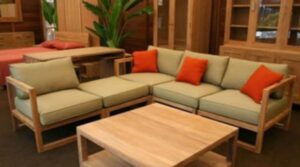Garden Furniture

Garden furniture is furniture installed to complement gardens, orchards, or other outdoor spaces. Garden furniture is now a necessary addition to homes, offices, and other buildings. Homes and buildings with large plots of land require garden furniture to fill and complement the garden, providing a place for rest, conversation, and other outdoor activities.
Although it serves the same function as other furniture, garden furniture must be designed and constructed to different specifications. As furniture placed in gardens, orchards, or outdoor spaces, garden furniture is made to be stronger, more durable, and resistant to outdoor conditions.
Here are some things to consider when selecting and manufacturing garden furniture: Selecting Materials for Furniture
The manufacture of garden furniture must begin with selecting the type of material used. Garden furniture that will be placed and used outdoors will be exposed to outdoor conditions such as sunlight, rain, changes in temperature, humidity, and other factors. Therefore, garden furniture must be made from strong materials and be ready to accept changes and outdoor conditions, so that this furniture can last and can perform its function well.
There are several materials that can be used to make furniture, but not all are durable and suitable for outdoor use. Wood, one of the main materials for furniture, comes in many varieties, and not all are suitable for outdoor use. Some of the most commonly used woods for garden furniture are teak and acacia. There are actually several other types of wood that are also quite strong for outdoor use, such as ironwood, bengkirai, and merbau, but their use for furniture is very rare. Another wood commonly used for garden furniture is oak, but this is imported and expensive.
Engineering wood materials such as plywood, MDF, blockboard, or particleboard are not recommended for garden furniture because they are generally not strong enough for outdoor use, unless they are made to specific specifications. If using metal, it is preferable to use aluminum or stainless steel, which are more resistant to water and outdoor air. If iron is chosen, a strong finishing layer is required to prevent rust, which can easily occur due to rainwater and humid outdoor conditions.
Finishing Selection
Most garden furniture is sold and used unfinished. However, as the furniture industry and market demand evolve, demand for garden furniture with specific colors and appearances requires a finishing process. This furniture requires the use of outdoor finishing materials that are weather-resistant. Fortunately, many finishing materials designed for outdoor use are now available, allowing for a custom finishing process. However, it’s important to note that outdoor finishing materials are relatively limited, and therefore the choice of colors and finishes for garden furniture is also relatively limited. Not all colors and appearances found in indoor furniture can be created for outdoor furniture.
Model and Design Selection
Garden furniture models and designs are also slightly different from indoor furniture. In addition to the limitations of the materials used, garden furniture must also be made with safety and ease of maintenance in mind. In general, garden furniture is made with simpler and more basic designs. Models with many carvings or intricate shapes are not recommended for garden furniture because they can be difficult to maintain and handle.
Use of supporting materials or supports
Like other furniture, garden furniture also requires fittings and supports for use, such as hardware, upholstery, backrests, seats, sofas, cushions, etc. Support materials for garden furniture should also be selected from materials that are resistant to outdoor weather.
Assembly materials such as glue, nails, hinges, and so on should also be selected from materials that are strong enough for outdoor use.



